Way, way back in August 2004 I did a page called Postcards from Down Under in which I showed off some postcards from the subway’s early days from 1904-1910. While my hard drive was in for repairs in May 2012, I was looking around in the collection for something to post (my recent photos were in the shop along with the computer) and I discovered I had plenty of postcards from that series I hadn’t yet used, hence the page you’re reading now.
These early postcards combine a matter-of-fact representation of NYC’s new transit medium along with some gee-whiz-bangery. Subways weren’t new when they opened in NYC in 1904 — they had already been in London for decades and in Boston for a few years already. But there was a palpable sense that in NYC they were going to be special and NYC’s would be the best. Almost 110 years later, it’s debatable whether they are. In NYC we can proudly say that we invented the concept of the express subway, which, in theory, shortens the trip (in recent years studies have shown that not a whole lot of time is saved).

This 1905 card shows the kiosk entrance to what was then the flagship NYC subway station at City Hall. It’s been closed since 1945 since its looped topography caused too great a gap between the platform and the newer subway cars of the period. In 2009, NYC closed its other loop station at South Ferry for pretty much the same reason, and built a new, straight platform terminal.
This photo was likely exposed on the Interborough Rapid Transit‘s (IRT) opening day, October 27, 1904. Festive crowds are on hand and City Hall is festooned with bunting.
[NYC’s Original 28 Subway Stations: City Hall is first]
The postcard was produced by the Underwood & Underwood firm:
Underwood & Underwood was an early producer and distributor of stereoscopic and other photographic images, and later was a pioneer in the field of news-bureau photography.
The company was founded in 1881 in Ottawa, Kansas, by two brothers, Elmer Underwood (born Fulton County, Illinois 1859 – died St. Petersburg, Florida 1947) and Bert Elias Underwood (born in Oxford, Illinois 1862 – died Tucson, Arizona 1943). They moved to Baltimore and then to New York City in 1891.
At one time, Underwood & Underwood was the largest publisher of stereoviews in the world, producing 10 million views a year. The Underwood brothers developed a selling system of thorough canvassing using college students. They distributed stereographs for Charles Bierstadt, J.F. Jarvis and the Littleton View Company. By 1887, they outgrew their original office in Ottawa and moved to New York City. Offices were also opened in Canada and Europe. In 1891, Bert learned how to operate a camera and thus the firm of Underwood & Underwood Publishing entered a new merchandising sphere. By 1897, the company had a number of full-time staff and free lance photographers. In the same year, the Underwoods purchased the businesses of Jarvis; Bierstadt; and, William H. Rau. Underwood & Underwood was publishing 25,000 stereographs a day by 1901. The firm still canvassed and sold its own stereographs. Around 1900, Underwood & Underwood introduced boxed sets, with specific themes, such as education and religion, and travel sets depicting popular tourist areas of the world. wikipedia

This postcard, by the Joseph Koehler Company of NYC, shows the tiled arch interior of the City Hall station, which was largely illuminated by skylight, though there were chandeliers holding electric lamps. The oakwood ticket windows are long gone. Before turnstiles and tokens started arriving in the Roaring Twenties, patrons would purchase a ticket at the window and hand it off to an attendant at the fence separating the fare control area, who would place it in a ticket chopper. The subway fare was 5¢ and remained at that amount all the way until 1948. The low price contributed to the deterioration of NYC’s transit that really didn’t begin to be turned around until the late 1980s.
Joseph Koehler, New York, NY: Founded as a printing firm 1892-1911, they later began publishing view-cards in both continuous tone and halftone lithography as well as real photo cards. They have been well known for their early hold to light postcards, mechanicals, and exposition cards, since publishing an unofficial postcard set of the 1893 World’s Columbian Exposition in Chicago. While most companies stopped using the expensive chromolithographic printing method in favor of the cheaper halftone printing process, Koehler (a pioneer in halftone technology) had returned to producing chromolithographs. Koehler postcards have a very distinct style to them and is the reason why Koehler postcards are so sought after by serious collectors. All of their postcards were printed in Berlin, Germany. Pop Up Studio NYC

Riding in a hole in the ground was truly a novel idea for New Yorkers in the 19-ohs, as vehicular tunnels were still a couple of decades off. Thus there arose a series of postcards showing the subway tunnels, and what could be found above them. On this postcard we see the Brooklyn Bridge station, now the first or last stop on the #6 train, and the grand Surrogates Court/NYC Hall of Records (completed 1907) at Centre and Chambers Streets. If you stand on the east side of City Hall Park opposite the bridge and look north, the view is still essentially the same.

This vantage point of City Hall is currently impossible for the general public, as the section of City Hall Park surrounding it is now under diligent police protection, a reflection of the Age of Terror. NYC’s City Hall was originally built from 1802-1812 (Mangin & McComb, arch.), but there have been periodic changes and alterations, the last happening in 1998.
The view of City Hall Station is remarkably similar in 2012 as in 1904; the skylights are still there, as are the chandeliers. Periodically, the Transit Museum leads tours into it.

I’m afraid I can’t place the postcard manufacturer (help me out here). Pretty much the same view but this time a look at the ticket window and staircase to the plaza.

You know, I was shockingly naive till a relatively older age and for some reason I had thought the trains ran in a tunnel that ran along the river bottoms and the walls stopped the water from rushing in. Only later did I realize that the tunnels ran under the riverbed. The top view is pretty much the same view you get from the Staten Island Ferry front or back, depending on whether you’re leaving or arriving. Of course the buildings from the 19-oh’s have been razed or are hidden by taller buildings by now.
The three arches in the middle of the photo are the back end of the 1907 Battery Maritime Building, from where you presently catch the ferry to Governors Island. The tall building in the center is the Singer Tower (1908-1967). The two portals on the left are for the Staten Island Ferry.

This card, by Illustrated Postal Card Novelty Co., show what is now the #2 and #3 train running under the east River to Brooklyn; the IRT reached the borough in 1908, just 4 years after the original 28 stations were built. In just about 10 years, miles of subway tunnels and track, hundreds of cars, and dozens of stations were built at the dawn of NYC subway travel. On the new Second Avenue Line to open in 2016 (and counting), billions of dollars and twenty years will be needed to open three new stations.
The view shows a sailboat, steamship, lighter, Brooklyn Bridge, and buildings in Brooklyn Heights.
Illustrated Post Card Company of 118 Chambers Street in New York was printing millions of cards at a time when picture postcards were at the peak of their popularity.
Another address given for them is 520 West 84th Street, New York and they operated from 1905 to 1914. They published a wide variety of color halftone lithographic cards in series that were printed by Emil Pinkau in Leipzig, Saxony. Each city or location of their color card sets were assigned the same number prefix.Their best known cards are from a very large set that captured scenes throughout the City of New York. These cards tended to use brighter than average colors and were titled in a very distinct font. Similar cards, but with more subdued writing, appeared afterwards depicting scenes from the surrounding regions such as Long Island. In 1909 they stopped importing cards from Germany and began printing their own. A large number of black & white cards were produced in a more open halftone with some being poorly hand colored. These black & white cards were numbered consecutively.
There was also another company with the same name that worked from 1907 to 1915 in Montreal, Canada. These published Canadian views in black & white and color continuous tones with the cards being made in Germany. TH Postcards

In the 19-oughts there was still no shortage of sailing ships in NYC’s surrounding waters, as the postcard shows. Not sure if that’s Brooklyn or Manhattan on the right.

Another twofer showing the Municipal Building (1907-1914), where I had my first radio interview on WNYC on October 23, 2006, and City Hall.

This view shows the Brooklyn Bridge station and the old Park Row el train terminal. A paying transfer to IRT Elevated trains such as the Third Avenue Line at the City Hall terminal, or a transfer to the Lexington Avenue Subway at the Brooklyn Bridge station, was available here.
For the first decade-and-a-half of its existence, it was used exclusively by trains of the New York and Brooklyn Bridge Railway, a cable-hauled line that spanned the length of the bridge between Park Row and another terminal at the Brooklyn end of the bridge.
On June 18, 1898, elevated trains of predecessor companies of the BMT began using the station during off-peak hours, while the cable-hauled shuttle continued to run at rush hours. On January 27, 1908 the shuttle was eliminated and elevated trains began running to Park Row at all times[1].
At its height, Park Row terminal had four platforms on four tracks in the main part of the terminal, and another three platforms on two tracks beyond (west of) the main train shed. This resulted in very complex scheduling and track shifting, so that most trains discharged their passengers at dedicated exit platforms and then were transferred to tracks on other platforms for loading of outgoing passengers. wikipedia
All of Brooklyn’s els, which were once surface steam RR lines, used the Brooklyn Bridge at one time to reach Manhattan. The terminal served the Myrtle Avenue, Brooklyn’s Lexington Avenue, Brooklyn’s 5th Avenue, the Culver (today’s F train), the West End (today’s D), and sea Beach (today’s N). As other subway routes became available, one by one the Brooklyn els ceased Brooklyn Bridge operations and by 1944 el trains stopped running on the Brooklyn Bridge, followed in short order by trolleys. The Bridge became the province of passenger cars, pedestrians and bicycles, the latter two in an uneasy alliance on the center boardwalk.
In the postcard the tall domed building was the home of the New York World newspaper, which had been founded in 1860 and purchased by Joseph Pulitzer in 1883. He built what was the largest skyscraper in the world here in 1890, employed Nellie Bly as one of the first investigative journalists, pioneered the four-color printing process, and ran Richard F. Outcault’s The Yellow Kid comic strip. Later, the World ran the first crossword puzzle in 1913. The World merged with the Evening Telegram newspaper in 1931, forming the NY World-Telegram in 1931, which after another series of mergers, perished in 1966.
The New York World Building was torn down in 1955 to make way for Brooklyn Bridge car ramps.
On the right in the postcard, we see the second New York Times building to occupy the corner of Park Row and Spruce Street.
There’s a “world” in each of these postcards.
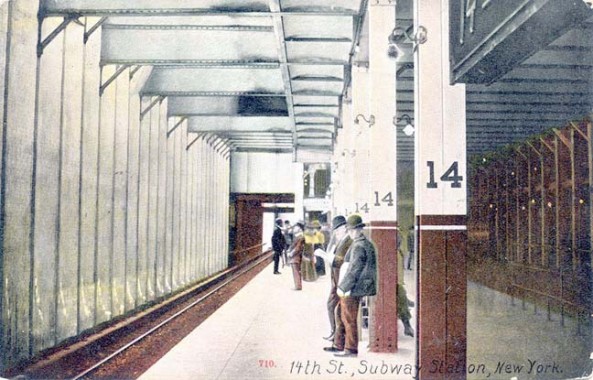
This is an early view of the first 14th Street station at Union Square. Later, transfers to two BMT lines, the Broadway Line (R, N) and 14th Street-Canarsie (L) would be made available here. Other than the paint job and modern signs on the columns, the platform looks essentially the same today, right down to the tile job on the left hand side walls. The platform is on a curve and automatic platform extensions, one of the last remaining ones in active service, can be found on a section of platform. Another can be found on the Times Square end of the Times Square Shuttle, itself part of the first subway line built in NYC in 1904.

A view from the trackbed of the Lexington Avenue Line 18th Street Station, located at Park Avenue South. The station is still there, but has been abandoned since 1948, when the 14th Street platforms were extended and the station was considered redundant.
[NYCSubway visits 18th Street]
Three postcard views of the 23rd Street Station on today’s #6 train. In an innovative development, a store on the ground floor could be accessed from the train, which was built close enough to the surface to allow skylighting to allow it to be partially lit by sunlight.
Since there are no longer steps descending to the platform, I’d have to think that it was removed and the stair to the street was extended down to the fare control.
The American Colortype Company, also known as the American Colortype Co. issued lithograph type stereoviews on very poor cardboard stock from roughly 1900 through the 1920’s. These lithographs are less abundant than most, but are still commonly seen. The company produced approximately 250 titles of decent photographic quality; only the card stock was poor. The coverage of their set was broad, including much of the U.S., Canada, and a noteworthy series of views of the Klondike in Alaska dated 1925. In addition the company produced coloring books, paper dolls and advertising items. They were one of the last producers of lithograph stereoviews. Views were issued to at least 1927. Yellowstone Stereo Views
In the black and white cards you can see the fence delineating the fare control area from the platforms. Attendants stand next to the ticket chopper.
The I.H. Blanchard Press produced postcards between 1901-1907.

This Detroit Publishing Co. card shows the heavy iron and glass entrance and exit kiosks at the 28th Street station at Park Avenue South. Beginning in 1904 the IRT built these large, ornate items, which became a bit cumbersome as sidewalks became more crowded and in the auto age, motorists found them blocking their view. Hence, all of them began to be phased out in the 1940s and all had been removed by the mid-1960s. Note there were two different types, one with rounded roofs for entrances, and peaked roofs for exits.
The [postcard] company was founded as the Detroit Photographic Company in the 1890s by Detroit businessman and publisher William A. Livingstone, Jr., and photographer and photo-publisher Edwin H. Husher. The company had the exclusive rights to the photochrom process for the American market.
Photochrom is a technique developed in Zürich, Switzerland, which allows the color enhancement of black-and white photography with the means of chromolithography. It allowed the company to mass-produce photorealistic color motifs long before color photography became economically feasible. The company specialized on postcards of American and European subjects, including cityscapes, reproductions of artwork, natural landmarks and folklore.
By the time of World War I, the company faced declining sales both due to the war economy and the competition from cheaper, more advanced printing methods. The company declared bankruptcy in 1924 and was liquidated in 1932. wikipedia

The grand Hotel Astor, which stood at Times Square from west 44th-45th Streets from 1904-1967, can be seen on the left in this Rotograph postcard view. It was replaced by the 54-story One Astor Plaza in the 1960s.
Built at a cost of $7,000,000 on land leased from William Waldorf Astor (great-grandson of John Jacob Astor, the fur trader), the 11-story, 35,000-square-feet Hotel Astor was designed in the French Renaissance “Beaux Arts” style by architects Charles W. Clinton and William H. Russell, who imitated many features from the old Waldorf-Astoria on Thirty-Fourth Street. The Hotel Astor opened in September 1904, dazzling guests with its enormous public rooms, most decorated with themes. A year later the elaborate roof garden was opened. NYC Ago
Located in New York City, 684 Broadway, with offices at 215 Wabash Avenue in Chicago as well, the Rotograph Company published as many as 60,000 cards. It had affiliate offices in Germany, England, and Italy, with its president presiding over production from Germany. Subjects ranged from scenic views of cities & towns to real photo portraits, to stylized greetings, to art reproductions, to comics. Rotograph

Looking at Columbus Circle in the early 19-oughts, the only remaining feature is Gaetano Russo’s 1892 sculpture of the Italian seafarer; it was erected in 1892 in the 400th anniversary year of his arrival in the Caribbean islands off the North American coast. Reproductions of the Bishops Crook post have appeared all over NYC beginning in the 1980s.
Here’s a panoramic view of Columbus Circle in 1907.
Three views of Columbia University at Broadway and West 116th Street. All of the buildings in these views still stand, except for the subway station house in the center of Broadway — but one that looks a lot like it is still there at the West 72nd street station. The park in the foreground has since been built upon by Columbia U. 116th Street, in the center of campus, is now the pedestrian-only Campus Walk.
Founded in 1754 as King’s College adjoining Trinity Church downtown, the campus moved to Morningside Heights in 1897.

Detroit Publishing Co. view of the subway tunnel under Broadway and West 117th. I don’t recognize the structure in the background.

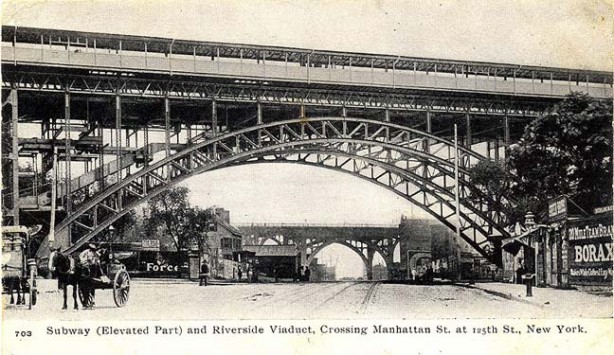
When building the subway through Manhattan Valley, IRT engineers chose to keep the subway level, and so allowed it to breach the surface and travel on a striking arch bridge above West 125th Street. The subway enters the tunnel again before reaching West 116th or East 137th Streets.
Similarly, the City built the equally monumental Riverside Drive Viaduct over the valley in 1900. It can be seen in the background in the bottom card.

An early IRT train stops at 125th Street. The factory, smokestack and water tank are long gone. In recent years Columbia University has purchased most of the properties there as it embarks on an expansion program.

Another look at the subway viaduct, this time from between Broadway and Riverside Drive. The script Coca-Cola logo is identical today.

Entrance (not exit) kiosks at the 137th Street station.
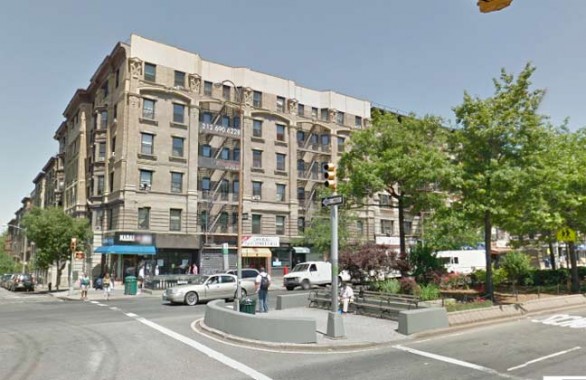
A check with Google Street View shows that the Cromwell Apartments are still there albeit in modified form.

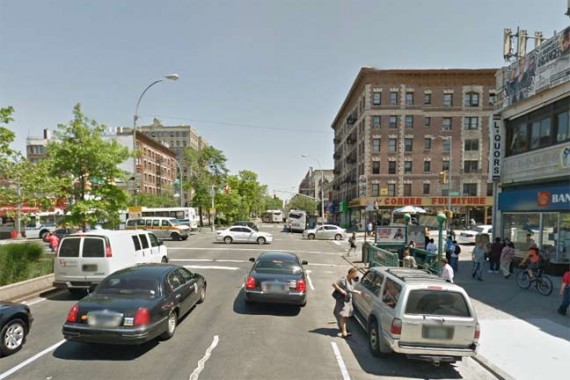
At 145th Street, Broadway still has a center mall, but there’s a lot more traffic in the 21st Century.
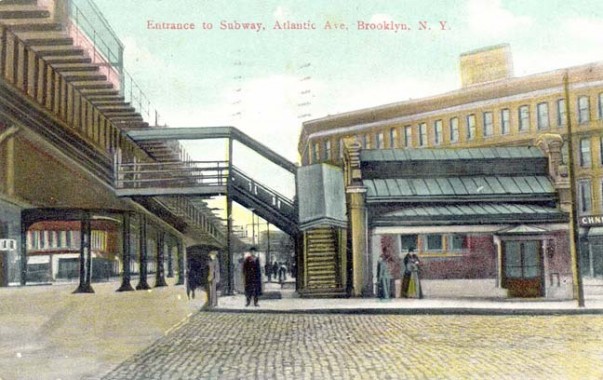
After the IRT was extended to Brooklyn beginning in 1908 postcards were produced showing some of the statin stops. The station house shown here, in the triangle made by Atlantic, Flatbush and 4th Avenue, still exists and has seen waves of deterioration and revival over the years. When I first saw it in the 1960s, it was surrounded by fast food kiosks. After they were removed, the house went through about 30 years of ruin until a renovation in the early 21st Century restored it, but made it a glorified skylight with no entrances or exits.
The Fifth Avenue El, here shadowing Flatbush Avenue, went out of business in 1940.

I hope the power was turned off on the third rail when these guys posed for the photo. These are the tracks of the Borough Hall station serving the original line to go through, the Lexington Avenue (today’s 4 and 5 trains). Later, connections were made to the 7th Avenue IRT (2 and 3) and the BMT Broadway line (R). The walkway over the tracks is still there.

The walls of the Boro Hall station still boast their original terra cotta tablets and wall tiles. They were last restored during a 1981-1982 refurbishing.
Pierre P. Pullis was the official IRT photographer in the early days.
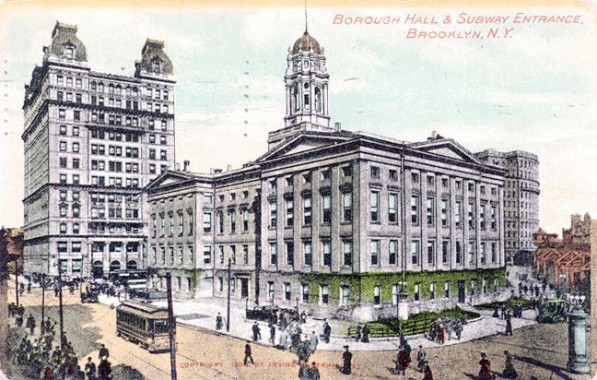
A look at Brooklyn’s Borough Hall, formerly its City Hall, on Joralemon Street. The Fulton Street El, which began demolition in 1942, can be fleetingly glimpsed on the right. The tall building on the left is the 1901 Temple Bar Building, for several years Brooklyn’s tallest. It was probably named for Dublin, Ireland’s Temple Bar neighborhood.
The building was designed by George Morse, a prominent Brooklyn architect of the time. As was common for the period, the building is in the Beaux-Arts style, and is capped with three copper cupolas on the street-facing corners. Each cupola is adorned with multiple human faces, male at the tips of the corners and female above the window pediments. The elaborate baroque ornament of the copula, however, is in contrast to the somewhat more reserved lower portion of the building. Some minor terra cotta ornament accentuates the horizontal divisions in the massing every two-to-four floors, but otherwise the building is clad in simple white brick. Even the rustication on the building’s corners is made from these bricks. The only other significant decorative elements are the arch and Corinthian columns that flank the central windows on the east façade, and the lion’s face, carved out of the granite base. Complex City Guide

A look at the express track at Spring Street under what was then Elm Street but is now Lafayette.
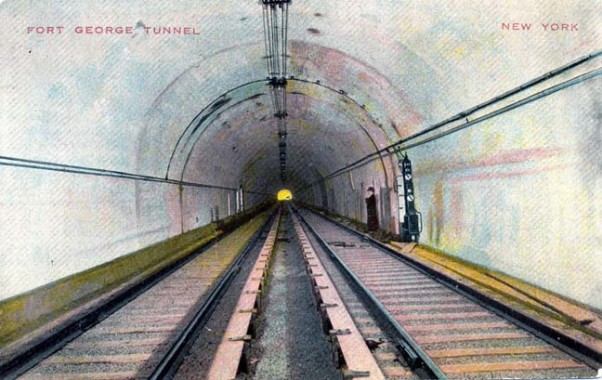
A view of the tunnel north of 191st Street. The approaching daylight is from the next station, Dyckman Street, where the IRT emerges from a deep tunnel under a hill and runs on an elevated line.

Three renderings from G. W. Peters accompanied the article “In the New York Subway” in The Century Illustrated Monthly magazine in London, England in 1909. The font is reminiscent of the one used on original stations of the Metro subway in Paris.

Subway patrons await patiently at Grand Central. They might have to wait awhile as a track worker is enroute to a problem, perhaps.

October 28, 1904 was Day Two of the IRT. Another postcard showing City Hall and the City Hall station under it.
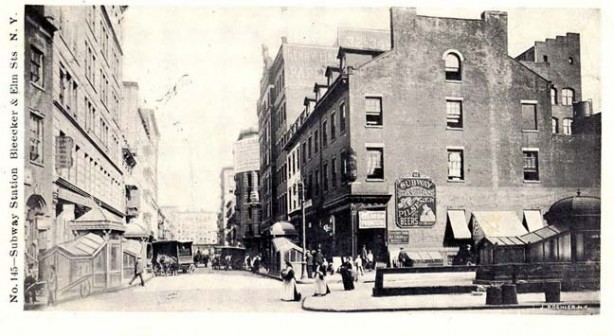
One last view, at Lafayette and Bleecker looking east. Mulberry Street ends at Bleecker just before it meets Lafayette. The sign indicates the Subway Tavern; Mulberry Plaza luxury apartments now stand on the site.
Note how big the entrance and exit kiosks are relative to subway width. That’s why they eventually had to go.
5/14/12


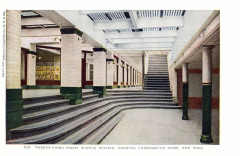
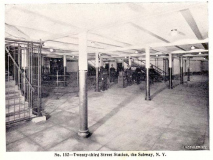
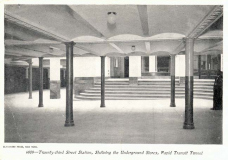
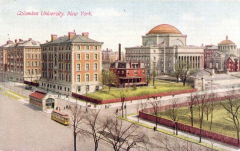
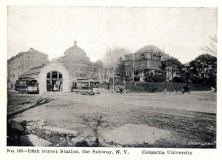
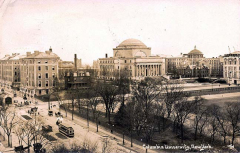
27 comments
Hey, how come I don’t see any metrocards on the subway floors? Great pictures!
Excellent post, Kevin!!! As a long time deltiologist, I can only wish that I owned the actual cards!!! And I love the mustache on the “Despatcher”!
Excellent postcards, thank you for sharing. Just a couple of corrections, in the view showing the harbor and the #2 and 3 tunnels in b/w: first, the tunnels are out of scale, they are mostly about forty feet beneath the harbor bottom. This was necessary because the bottom is mostly mud and soft silt in that area. At least one blowout occurred building this line. Construction crews were working under compressed air and one worker was blown clear thru the roof of the tunnel and forty more feet of NY Harbor, and picked up unharmed by a tug in the bay. Second, of the three ships shown above the tunnels, the one on the far right is not a tug, it’s a lighter, a specialized boat designed to carry freight from deep draft oceangoing ships to the shallow water piers, before the piers were dredged deep. The NY Central railroad had a large fleet of them, as did the Pennsylvania. I worked on restoring one for the South Street Seaport Museum, back in the days before they became a shopping mall, it was NY Central #29. It was later scrapped; I guess it was more important to build yet another Brookstone’s or Abercrombie and Fitch than to spend the cash on actual museum work….oh well!
I remember tghe kiosks that were at 135th & Lenox Avenue from the late 1950s.
Aren’t the platform extenders at Times Square on the Grand Central-Times Square shuttle line still in service, in addition to the ones at 14th?
You’re right.
I thought they also had the platform extenders at Grand Central on the 4/5/6, and I know that they used to operate them on the South Ferry 1 loops until the loops’ retirement in 2009.
3rd rail got a wooden cover over it to protect the feets even with power on
You can put feet on rail itself provided you got rubber soles preferably Cons
Those postcards are excellent. I have just a few questions. One: in the 14th Street postcard, you mentioned that the active platform extensions at the station are “one of the last remaining ones in active service”. Are they being replaced or something? Two: “…Google Street View shows that the Cromwell Apartments are still there albeit in modified form.” Three: How many volts was the third rail in the picture at the time (I know that they’re currently 625V). So are they less beautiful or more beautiful? Other than that, thanks for sharing these pictures.
When I saw a film over at the NY Transit Museum, it was said that upper Manhattan was still pretty rural before the subway came there. Part of that reason was because it was pretty isolated at the time from the rest of the island without good transit of getting there, plus the 8th Avenue El didn’t even go past Washington Heights to Inwood when it crossed the Harlem River at 155th Street. Meanwhile, that postcard with the 5th Avenue with that walkway for the Atlantic Avenue Station does remind me of something like this in Chicago.
excellent postcards review of nyc trains im a train buff thank you.
Awww gee,ya never let a guy have any fun
Fascinating series of images !
One more correction: Gaetano Russo’s 1892 sculpture at Columbus Circle was erected for the 400th anniversary, not the 500th.
I’m not good at math
Can someone explain what the width of the kiosk has to do with the width of the subway and why that meant that they had to go?
Thanks.
They were too wide for the sidewalks and were also making it hard for motorists to see what was ahead
A note about the postcards of the 23rd St. 6 train station: The steps still exist down to the platform as does the storefront! There is a decorative gate and turnstiles blocking the way to the tracks, so it’s not open directly to the platform now. The storefront you mention was the downstairs of a Woolworth’s (on 23rd) until the late 80’s. It’s now Spin, a Ping Pong Club, and while you can’t enter directly from the subway anymore, you can see the action through the windows!
The one aspect that does not seem to exist now is the arcade that disappears into the distance behind the stairs in the top right postcard. There’s just a wall behind the stairs. Who knows-perhaps there’s still a hidden arcade down there!
The Card with IRT train at 125th St, with a “Smoke-stack & ‘water tank'” in distance, actually shows a Gas Works and Storage ank- these expandable tanks, folding up similar to a multi-layered, massively wide, steel telescope, were surrounded by a truss-like frame. These were common until the 1970s in a lot of industrial areas- used for storage of ‘Pressurized Natural Gas’ . These types of tanks were long used as landmarks, even to the 1990s- as in many a traffic report mentioning ‘the Elmhurst Tanks’, on Long Island. There seemed to be many of these tanks along rail-lines (and canals) especially because many factories made their own gas from Coal (heating coal, without combustion; causing Methane and such to form ) and needed rail transport for the bulky coal shipments. I grew up a few miles away from such a ‘Gas-works’ and Gas-storage tank, along the NY & Long Branch RR tracks that was in Belmar NJ. Always like your articles, and your historical notes and such. Thanks for doing this !
Kevin, you just brought it all together for me with this one: history, art and artistry, architecture and, best of all, nostalgia. The Forgotten love affair is anything but its namesake.
[…] Source 40.807879 -73.945415 Rate this:Tell A Friend:Like this:Like Loading… This entry was posted in Harlem, Harlem architecture, Harlem real estate and tagged 144th Street and Broadway, 145th Street (Manhattan), Broadway, Central Harlem, Harlem, Robert Moses. Bookmark the permalink. ← HEAF Students Conduct Mock trial With United States Circuit Judge […]
[…] Source 40.807879 -73.945415 Rate this:Tell A Friend:Like this:Like Loading… This entry was posted in Harlem, Harlem architecture, Harlem real estate, Manhattanville and tagged 125th Street, Harlem, Interborough Rapid Transit Company, IRT, Manhattan Valley, Manhattanville, New York City, Rapid transit, Riverside Drive viaduct. Bookmark the permalink. ← Walter’s World: Dance Iquail […]
[…] In recent years Columbia University has purchased most of the properties in the area as it embarks on an expansion program (source). […]
[…] Source […]
[…] Source […]
[…] Source 40.807879 -73.945415 Rate this:Tell A Friend:Like this:Like Loading… This entry was posted in Harlem and tagged 72nd Street, Broadway, Broadway theatre, Central Park West, Columbia University, John Williams, Metro station, West. Bookmark the permalink. ← New Yorkers for Real Immigration Reform Join with Artists […]
[…] campus in Morningside Heights, New York City was relatively new. In the center of Broadway stood a one-story brick subway station, which was eventually knocked down and replaced by an underground station in the center of the […]